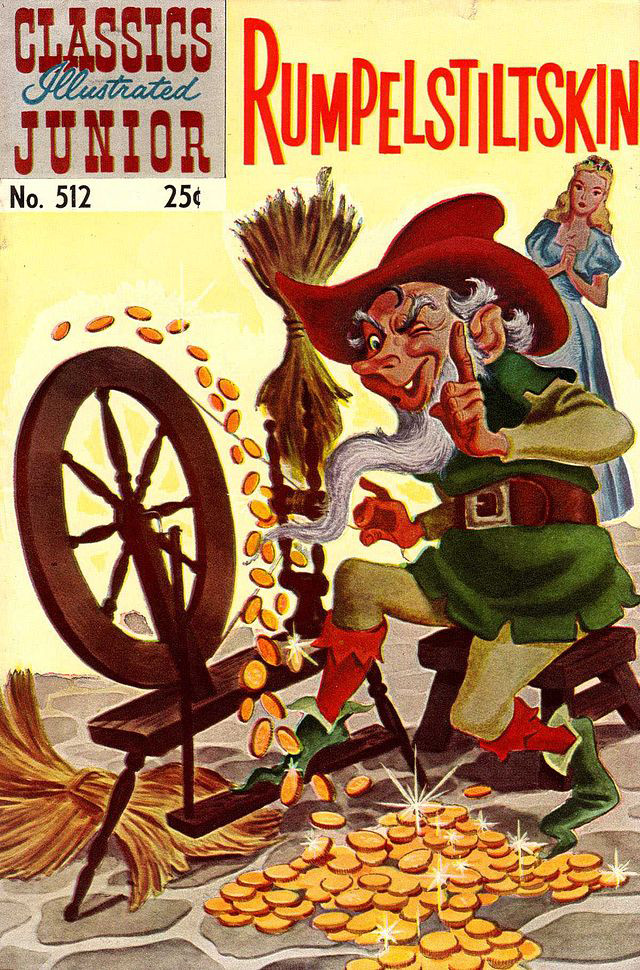
by Ward Chesworth Thursday, April 16, 2015

Credit: Public Domain.
The title above may sound like one of those Robert Ludlum novels that works better as a movie than it does in the author’s long-winded prose. But my intention is to emphasize the importance of names, an importance children often first learn about from fairy tales or folklore. In one of the “Children’s and Household Tales” collected by the Brothers Grimm in 19th-century Germany, Rumpelstiltskin is a dwarf whose magical abilities spring from his secret name. For the price of her first-born child, he helps a girl fool a king into thinking that she can spin straw into gold and thereby solve His Majesty’s major cash-flow problem. Rumpelstiltskin does the spinning and the grateful king makes the girl his queen. Demanding his reward, the dwarf reappears when the queen gives birth. She pleads for mercy; the dwarf relents and gives her three days to guess his name before she loses the child. If he had had a common name like Jim or Fred or even Gunter, the task would have been hard enough, but his name is an outlier among monikers. Yet, by subterfuge she discovers the answer in time, and the dwarf storms off, madder than Yosemite Sam after his cigar explodes.
In science, it is the taxonomists’ job to manage names. They take the objects we study and construct classifications wherein each distinct object is assigned its own pigeonhole and tagged with a specific name. It may be a familiar name like limestone, or something barbarous like rumpelstiltskinite. (Sadly, that doesn’t exist, but actual monstrous mineral monikers include jacupirangite and melteigite-jotunite, for instance, among many others.) The aim is to give some semblance of order to the chaos of nature and, when done right, classification can even be an important route to new knowledge. Mendeleev showed us this by spinning gold from the disorganized jumble of elements known in his day to create his Periodic Classification — and then use it to predict elements unknown at the time.
Controversy arises, however, in deciding how many names are enough. Take the International Giraffe Working Group, for example. It may sound like a Monty Python skit in which tall animals gather in a committee room with a very high ceiling, but it’s actually a serious group of specialists trying to decide whether to leave giraffes safely lumped together as one species under one name, or to split them into six species with six names. “Lumpers and splitters” is the informal taxonomy of taxonomists first suggested to Charles Darwin by Hewett Watson in 1855, and a couple of years later Darwin passed the terms on to J.D. Hooker in a letter. “It is good to have hair-splitters and lumpers. (Those who make many species are the ‘splitters,’ and those who make few are the ‘lumpers’),” he wrote.
Excessive splitting can lead to problems, though. If an overly meticulous taxonomist kept on splitting hairs ad absurdum, we would wind up with a classification resembling an advanced case of logorrhea, the kind of thing guaranteed to drive working geologists to the brink. C.B. Hunt staged his own rebellion against this tendency when he considered the plethora of names invented for minor igneous intrusions. He expressed his displeasure by sarcastically concocting one more, cactolith, which he described as “a quasi-horizontal chronolith composed of anastomosing ductoliths whose distal ends curl like a harpolith, thin like a sphenolith, or bulge discordantly like an atmolith or ethmolith.” He insinuated it into his 1953 U.S. Geological Survey professional paper on the Henry Mountains of Utah, and from there it crept under the radar into the first edition of AGI’s very own “Glossary of Geology.” Unfortunately, some humorless jobsworth banned it from all subsequent editions.
In my career, I have come across both splitters and lumpers. In 1956, William Scott MacKenzie left the Geophysical Laboratory at the Carnegie Institution for Science in Washington, D.C., for the University of Manchester in England. To me and my fellow undergrads at Manchester, his association with the “Gee-Whiz” Lab in D.C. only added to the Scottish charisma that Mac possessed in abundance. Whenever I visited England later in life, I would drop in to see him for a good gossip. One time, I found him in the smoky gloom of his dusty office, peering down a petrographic microscope. He invited me to name the volcanic rock he was examining, and seeing plagioclase and pyroxene, I pronounced it basalt. “A fat lot you know, Chesworrrth,” he bellowed, with a fine Hibernian rolling of the “r.” “You hav’nae lairnt a damn thing since you left here. Can you no’ see it’s a mugearite, man?” Mac was a splitter — calling his sample basalt made me a frivolous and imprecise lumper. Later, over lunch with the inevitable pint of warm beer, he added, “Och, you’re just a bluidy arm-waver.” But he was a humane man — he let me keep my first born.
As time went by, Mac’s red beard turned to gray, and a friendship spiced with 40 years’ worth of gratuitous insults ended when he died in 2001. And, so, the question of splitting or lumping lives on.
© 2008-2021. All rights reserved. Any copying, redistribution or retransmission of any of the contents of this service without the expressed written permission of the American Geosciences Institute is expressly prohibited. Click here for all copyright requests.